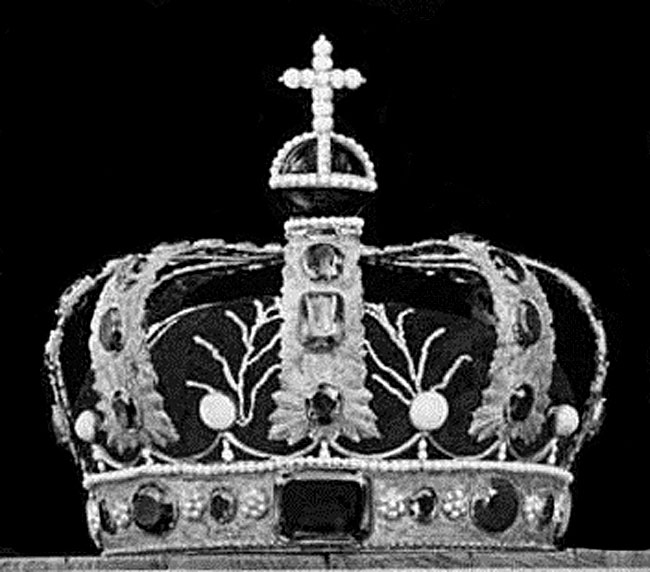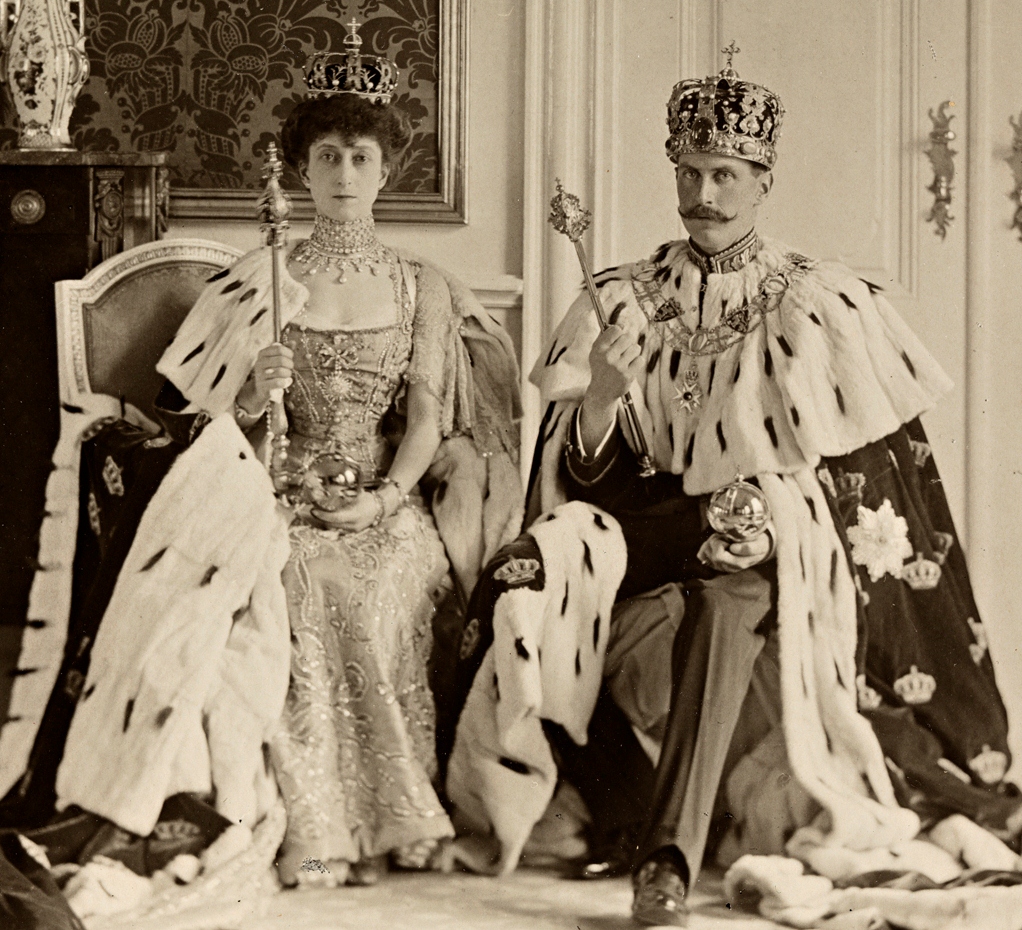|
Queen Of Norway's Crown
The crown for the Queen consort of Norway was made in 1830 for Désirée Clary's coronation. It did not take place, and was first used in 1860, for the coronation of Louise of the Netherlands. It was made in Stockholm and, though it is unknown by whom, probably by Marc Giron, the royal jeweller, some have speculated it may have been by Erik Lundberg, or, perhaps is a combination of both's work, and the design is probably based on the Swedish queen's crown. It is made of silver-gilt and gold, and is decorated with a number of multicoloured gems and pearls, including violet (Amethysts), yellow ( Citrine and Topaz) and green (chrysoprase). It weighs approx 530g. See also * Regalia of Norway The regalia of Norway are items that symbolise the Norwegian monarch's power and majesty. Little is known of the old Norwegian regalia which have since been lost. The majority of the modern regalia date from 1818 and were made for the coronatio ... ReferencesOfficial Site - The crown i ... [...More Info...] [...Related Items...] OR: [Wikipedia] [Google] [Baidu] |
Citrine Quartz
Quartz is a hard, crystalline mineral composed of silica (silicon dioxide). The atoms are linked in a continuous framework of SiO4 silicon-oxygen tetrahedra, with each oxygen being shared between two tetrahedra, giving an overall chemical formula of SiO2. Quartz is the second most abundant mineral in Earth's continental crust, behind feldspar. Quartz exists in two forms, the normal α-quartz and the high-temperature β-quartz, both of which are chiral. The transformation from α-quartz to β-quartz takes place abruptly at . Since the transformation is accompanied by a significant change in volume, it can easily induce microfracturing of ceramics or rocks passing through this temperature threshold. There are many different varieties of quartz, several of which are classified as gemstones. Since antiquity, varieties of quartz have been the most commonly used minerals in the making of jewelry and hardstone carvings, especially in Eurasia. Quartz is the mineral defining the valu ... [...More Info...] [...Related Items...] OR: [Wikipedia] [Google] [Baidu] |
Silver-gilt Objects
Silver-gilt or gilded/gilt silver, sometimes known in American English by the French term vermeil, is silver (either pure or sterling) which has been gilded with gold. Most large objects made in goldsmithing that appear to be gold are actually silver-gilt; for example most sporting trophies (including medals such as the gold medals awarded in all Olympic Games after 1912) and many crown jewels are silver-gilt objects. Apart from the raw materials being much less expensive to acquire than solid gold of any karat, large silver-gilt objects are also noticeably lighter if lifted, as well as more durable (gold is much heavier than even lead and is easily scratched and bent). For objects that have intricate detail like monstrances, gilding greatly reduces the need for cleaning and polishing, and so reduces the risk of damage. Ungilded silver would suffer oxidation and need frequent polishing; gold does not oxidize at all. The "gold" threads used in Goldwork (embroidery), embroidered ... [...More Info...] [...Related Items...] OR: [Wikipedia] [Google] [Baidu] |
Norwegian Monarchy
Norwegian, Norwayan, or Norsk may refer to: *Something of, from, or related to Norway, a country in northwestern Europe *Norwegians, both a nation and an ethnic group native to Norway *Demographics of Norway *The Norwegian language, including the two official written forms: **Bokmål, literally "book language", used by 85–90% of the population of Norway **Nynorsk, literally "New Norwegian", used by 10–15% of the population of Norway *The Norwegian Sea Norwegian or may also refer to: Norwegian *Norwegian Air Shuttle, an airline, trading as Norwegian **Norwegian Long Haul, a defunct subsidiary of Norwegian Air Shuttle, flying long-haul flights *Norwegian Air Lines, a former airline, merged with Scandinavian Airlines in 1951 *Norwegian coupling, used for narrow-gauge railways *Norwegian Cruise Line, a cruise line *Norwegian Elkhound, a canine breed. *Norwegian Forest cat, a domestic feline breed *Norwegian Red, a breed of dairy cattle *Norwegian Township, Schuylkill County, ... [...More Info...] [...Related Items...] OR: [Wikipedia] [Google] [Baidu] |
State Ritual And Ceremonies
State may refer to: Arts, entertainment, and media Literature * ''State Magazine'', a monthly magazine published by the U.S. Department of State * ''The State'' (newspaper), a daily newspaper in Columbia, South Carolina, United States * ''Our State'', a monthly magazine published in North Carolina and formerly called ''The State'' * The State (Larry Niven), a fictional future government in three novels by Larry Niven Music Groups and labels * States Records, an American record label * The State (band), Australian band previously known as the Cutters Albums * ''State'' (album), a 2013 album by Todd Rundgren * ''States'' (album), a 2013 album by the Paper Kites * ''States'', a 1991 album by Klinik * ''The State'' (album), a 1999 album by Nickelback Television * ''The State'' (American TV series), 1993 * ''The State'' (British TV series), 2017 Other * The State (comedy troupe), an American comedy troupe Law and politics * State (polity), a centralized political organization ... [...More Info...] [...Related Items...] OR: [Wikipedia] [Google] [Baidu] |
Individual Crowns
An individual is that which exists as a distinct entity. Individuality (or self-hood) is the state or quality of being an individual; particularly (in the case of humans) of being a person unique from other people and possessing one's own Maslow's hierarchy of needs, needs or goals, rights and moral responsibility, responsibilities. The concept of an individual features in diverse fields, including biology, law, and philosophy. Etymology From the 15th century and earlier (and also today within the fields of statistics and metaphysics) ''individual'' meant "divisible, indivisible", typically describing any numerically singular thing, but sometimes meaning "a person". From the 17th century on, ''individual'' has indicated separateness, as in individualism. Law Although individuality and individualism are commonly considered to mature with age/time and experience/wealth, a sanity, sane adult human, human being is usually considered by the State (polity), state as an "individu ... [...More Info...] [...Related Items...] OR: [Wikipedia] [Google] [Baidu] |
Regalia Of Norway
The regalia of Norway are items that symbolise the Norwegian monarch's power and majesty. Little is known of the old Norwegian regalia which have since been lost. The majority of the modern regalia date from 1818 and were made for the coronation of Jean Bernadotte as King Carl III Johan. The Norwegian royal regalia include nine items: the king's crown, the sword of the realm, the king's sceptre, the king's orb, the queen's crown, the queen's sceptre, the queen's orb, the crown of the crown prince and the anointing horn. Also in this collection are several mantles, two banners of the realm and coronation thrones. The last king and queen in Norway to be crowned were Haakon VII and his wife Maud of Wales in 1905. Thereafter, the regalia have since not been used to physically crown or to be worn by successive monarchs. Certain items are still used occasionally such as during the monarch's consecration, where the crown is displayed; or during the monarch's funeral service, where i ... [...More Info...] [...Related Items...] OR: [Wikipedia] [Google] [Baidu] |
Chrysoprase
Chrysoprase, chrysophrase or chrysoprasus is a gemstone variety of chalcedony (a cryptocrystalline form of silica) that contains small quantities of nickel. Its color is normally apple-green, but varies to deep green. The darker varieties of chrysoprase are also referred to as prase. (However, the term prase is also used to describe chlorite-included quartz, and to a certain extent is a color-descriptor, rather than a rigorously defined mineral variety.) Chrysoprase is cryptocrystalline, which means that it is composed of crystals so fine that they cannot be seen as distinct particles under normal magnification. This sets it apart from rock crystal, amethyst, citrine, and the other varieties of crystalline quartz. Other members of the cryptocrystalline silica family include agate, carnelian, and onyx. Unlike many non-transparent silica minerals, it is the color of chrysoprase, rather than any pattern of markings, that makes it desirable. The word chrysoprase comes from the Greek ... [...More Info...] [...Related Items...] OR: [Wikipedia] [Google] [Baidu] |
Topaz
Topaz is a silicate mineral of aluminium and fluorine with the chemical formula Al Si O( F, OH). It is used as a gemstone in jewelry and other adornments. Common topaz in its natural state is colorless, though trace element impurities can make it pale blue or golden brown to yellow orange. Topaz is often treated with heat or radiation to make it a deep blue, reddish-orange, pale green, pink, or purple. Although it is often associated with golden yellow and blue, it comes in a variety of colors, including colorless. The rarest are natural pinks, reds, and delicate golden oranges, sometimes with pink hues. Topaz is a nesosilicate mineral. It is one of the hardest naturally occurring minerals and has a relatively low index of refraction. It occurs in many places in the world. Etymology The name "topaz" is usually believed to be derived (via Old French: Topace and Latin: Topazus) from the Greek ''Τοπάζιος'' (Topázios) or ''Τοπάζιον'' (Topázion), from Τοπα� ... [...More Info...] [...Related Items...] OR: [Wikipedia] [Google] [Baidu] |
Amethysts
Amethyst is a violet variety of quartz. The name comes from the Koine Greek αμέθυστος ''amethystos'' from α- ''a-'', "not" and μεθύσκω (Ancient Greek) / μεθώ (Modern Greek), "intoxicate", a reference to the belief that the stone protected its owner from drunkenness. Ancient Greeks wore amethyst and carved drinking vessels from it in the belief that it would prevent intoxication. Amethyst, a semiprecious stone, is often used in jewelry and is the traditional birthstone for February. Structure Amethyst is a purple variety of quartz (SiO2) and owes its violet color to irradiation, impurities of iron and in some cases other transition metals, and the presence of other trace elements, which result in complex crystal lattice substitutions.Michael O'Donoghue (2006), ''Gems'', Butterworth-Heinemann, 6th ed. The hardness of the mineral is the same as quartz, thus making it suitable for use in jewelry. Hue and tone Amethyst occurs in primary hues from a l ... [...More Info...] [...Related Items...] OR: [Wikipedia] [Google] [Baidu] |
List Of Norwegian Consorts
This is a list of Queen consort, queens consort of Norway. This list covers a large time span and the role of a queen has changed much over the centuries, with some individual queens also shaping their own roles. Many have ruled the country side by side with their husband and some have become sole regents. The marriage of an heir or a king was most often affected by politics and alliances were often affirmed by marriages in the royal families. It was also not permitted for a long period for royalty to marry non-royalty. Thus the choice of wife would be narrow in one's own country and most of the queens in this list are not native to their husband's country. Due to unions with Denmark and Sweden the queens listed for 1380–1814 were also queens of Denmark and the queens listed for 1814–1905 were also queens of Sweden. Fairhair dynasty Knýtling dynasty Unclassified Knýtling dynasty St. Olaf dynasty Knýtling dynasty Hardrada dynasty Gille dynasty ... [...More Info...] [...Related Items...] OR: [Wikipedia] [Google] [Baidu] |






